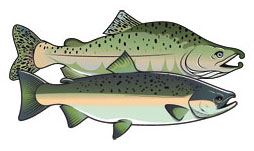|
History of Red Caviar
Health Benefits
Recipes
Nutrition Facts
Caviar Storage
|
History of Red Caviar
Caviar has been documented as far back in history as the 13th century. At the time,
it was black sturgeon caviar being served to Russian tsars and nobility. In the
Russian language, the root words for “beautiful” and “red” are the same. Historians
of the 13th century, writing about black sturgeon caviar referred to it as “beautiful”
caviar. Later, in the 1800’s it was referred to as “red caviar”, despite its black
color, because that is what Russian people had been calling it for years. In point
of fact, it is salmon caviar, not sturgeon, which is truly red in color.
Some sources inaccurately cite red salmon caviar as existing for as long as 400
years. It wasn’t until relatively recently, in the late 19th century, during the
exploration of the Far East, that salmon roe was discovered. At first it was only
salted and then eaten whole, in the skein, or egg sack. In Russia, that product
was very cheap, only costing 20 kopecks for 30 pounds, but did not become popular,
mostly due to the fact that its unprocessed state did not do much to improve the
initial flavor. It wasn’t until the roe was processed as grained red caviar, about
100 years ago, that it increased in popularity. Grained salmon caviar was cultured
in a similar process to that of sturgeon caviar. The roe was separated from the
skein and rubbed through a sieve. Rather than using drying salt as with the traditional
technique of making grained caviar, salmon caviar was salted with saturated brine.
It was then chilled and delivered to the western parts of Russia and becoming the
standard of caviar Russians expect and demand.
 Grained red salmon caviar became well-liked in other parts of the world as well.
Japanese people wanted this product for its distinctive, red color and exquisite
taste. Because of the product’s high demand, they decided to learn how to make grained
salmon caviar themselves, which was named “ikura,” closely resembling the Russian
word for caviar “ikra”. With its increasing popularity, red, grained salmon caviar
began to compete with the traditional black sturgeon caviar.
Grained red salmon caviar became well-liked in other parts of the world as well.
Japanese people wanted this product for its distinctive, red color and exquisite
taste. Because of the product’s high demand, they decided to learn how to make grained
salmon caviar themselves, which was named “ikura,” closely resembling the Russian
word for caviar “ikra”. With its increasing popularity, red, grained salmon caviar
began to compete with the traditional black sturgeon caviar.
 Salmon caviar gained its nickname, “red caviar,” in the USSR when the name referred
to the color to more easily differentiate salmon caviar from sturgeon caviar. In
the Soviet Union, salmon caviar sales and production were highly-regulated by the
government so the caviar was produced exclusively in the standard 140-gram can.
Both black and red caviars were very scarce and could only be obtained through close
connections with a caviar vendor. Caviar never appeared on shelves; it was always
sold out before it could be displayed in the store.
Salmon caviar gained its nickname, “red caviar,” in the USSR when the name referred
to the color to more easily differentiate salmon caviar from sturgeon caviar. In
the Soviet Union, salmon caviar sales and production were highly-regulated by the
government so the caviar was produced exclusively in the standard 140-gram can.
Both black and red caviars were very scarce and could only be obtained through close
connections with a caviar vendor. Caviar never appeared on shelves; it was always
sold out before it could be displayed in the store.
Today in Russia, red caviar is widely available. Since the Russian government no
longer regulates it, manufacturers and distributors of red caviar must compete for
customers as with any other free-market economy.
|
People in the Far East knew about the exciting properties of roe for a long time.
Traditionally, newly-weds were treated with roe on their wedding night to help add
to the couple’s enjoyment.
|
 Grained red salmon caviar became well-liked in other parts of the world as well.
Japanese people wanted this product for its distinctive, red color and exquisite
taste. Because of the product’s high demand, they decided to learn how to make grained
salmon caviar themselves, which was named “ikura,” closely resembling the Russian
word for caviar “ikra”. With its increasing popularity, red, grained salmon caviar
began to compete with the traditional black sturgeon caviar.
Grained red salmon caviar became well-liked in other parts of the world as well.
Japanese people wanted this product for its distinctive, red color and exquisite
taste. Because of the product’s high demand, they decided to learn how to make grained
salmon caviar themselves, which was named “ikura,” closely resembling the Russian
word for caviar “ikra”. With its increasing popularity, red, grained salmon caviar
began to compete with the traditional black sturgeon caviar.
 Salmon caviar gained its nickname, “red caviar,” in the USSR when the name referred
to the color to more easily differentiate salmon caviar from sturgeon caviar. In
the Soviet Union, salmon caviar sales and production were highly-regulated by the
government so the caviar was produced exclusively in the standard 140-gram can.
Both black and red caviars were very scarce and could only be obtained through close
connections with a caviar vendor. Caviar never appeared on shelves; it was always
sold out before it could be displayed in the store.
Salmon caviar gained its nickname, “red caviar,” in the USSR when the name referred
to the color to more easily differentiate salmon caviar from sturgeon caviar. In
the Soviet Union, salmon caviar sales and production were highly-regulated by the
government so the caviar was produced exclusively in the standard 140-gram can.
Both black and red caviars were very scarce and could only be obtained through close
connections with a caviar vendor. Caviar never appeared on shelves; it was always
sold out before it could be displayed in the store.